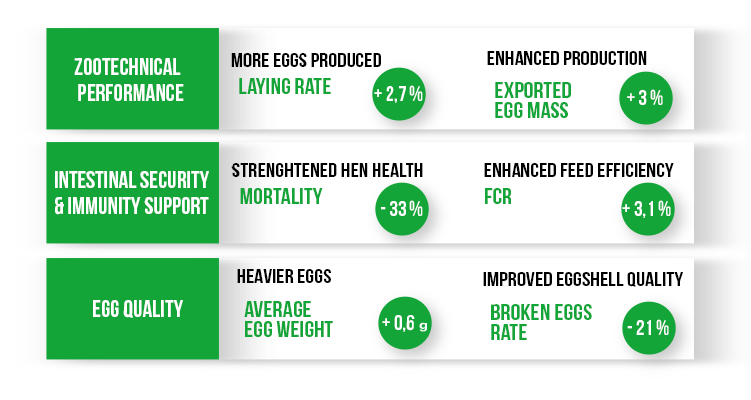Blog | Reading Time 5 minutes
Bactocell in layers, already 20 years of feedback: time for a meta-analysis with 62 trials!
The poultry industry and scientific community acknowledge the interest of probiotics to sustain modern productions: for both zootechnical improvements and sanitary control, the use of live microorganisms is more and more routinely used in the field.
Over the past two decades, literature has extensively documented the use of the probiotic Pediococcus acidilactici MA18/5M (Bactocell) in poultry, whose strain collection number was recently updated to CNCM I-4622. This lactic acid bacteria was specifically selected for monogastric for its high ability to produce an exclusive form of L-lactic acid. This is a direct source of energy for the birds through its absorption at the epithelial level or indirectly through a cross-feeding pathway as a substrate for bacteria producing short-chain fatty acids (like the butyrate producers). Today, Pediococcus acidilactici CNCM I-4622 is one of the most documented strains with more than 100 peer-reviewed papers. Indeed, the first registration in the EU for broiler applications was obtained in 1999, and Bactocell is already celebrating its 25 anniversaries of successful applications worldwide. The first scientific trial in layers with a control group was launched in 2005, and many followed over the world. Classical zootechnic parameters in layers (laying rate, FCR, broken eggs, and mortality rate) are still important parameters for producers, especially in the current context of the extended life cycle of hen due to high pullets cost and lack of eggs. A meta-analysis aiming to assess the impact of PA supplementation on the production performance of layers was realized after a massive campaign of trial collection at the commercial dose (100g of BACTOCELL/ton of complete feed). A total of 62 studies have been compiled, including both academic works and field trials, coming from 25 different countries wherein the performance of hens, from different commonly used breeds, with Pediococcus acidilactici supplementation (1x10e9 CFU/kg feed) was compared to a negative control.
Each trial reported at least one of two major performance criteria: 1) laying rate and/or 2) feed conversion ratio (FCR). In addition, other parameters regularly reported were egg quality (weight, exported egg mass (EEM) & number of broken eggs) and mortality. The studies were subjected to statistical analysis using a Mixed Model approach (SPSS 29.0), including treatment (supplemented or not), trial type (academic vs. field), housing type (cage: Yes vs No) and production phase (Full cycle (> 5 months); Beginning of lay (18-35 weeks old); Middle of lay (35-55 weeks old); End of lay (55-80 weeks old); Extreme end of lay (> 80 weeks)) as fixed effects. Additionally, the study was introduced as a random factor.
An important outcome of this meta-analysis is the similar performances regardless of the type of study, type of housing, or production phase for laying rate and egg weight. FCR was impacted by the type of housing, being significantly lower in cages. Mortality was lower in cages and higher for full-cycle studies. Supplementation with PA significantly improved the laying rate by 2.7% (P<0.01) and enhanced FCR by 3.1% (P<0.01). The average egg weight was 0.6g higher for the BACTOCELL-supplemented hens (P<0.05). Higher laying rates and heavier eggs led to a significantly higher EEM (0.361 vs 0.372 kg/hen/week; P<0.001). In addition, the incidence of broken/downgraded eggs was substantially reduced by 21% (P<0.05). Also, PA supplementation decreased the mortality rate by -33% (3.1 vs 4.6 %; P<0.01). The latter was more pronounced for layers in non-cage systems compared to hens housed in cages (-36% vs -24% respectively, P<0.05). Overall, this meta-analysis, combining results from over 60 studies, underscores the benefits of probiotic supplementation in augmenting the overall performance of laying hens across diverse production settings and throughout various production phases (Demey et al., 2024).
Zootechnical improvement with Bactocell benefits today robust experiences in many countries. Economical calculation demonstrates an important return on investment of 1 to 10 for a full egg production cycle supplementation at the recommended dose.
The unique mode action of Pediococcus acidilactici CNCM I-4622 contributes to its efficiency: the laying rate is improved through a better persistency of the laying curve thanks to a better utilization of nutrients. A model of energy valorization realized with a low-energy diet showed that BACTOCELL-supplemented hens get the same performances as the control birds with standard energy. The authors conclude that Bactocell compensates the energy loss by better feed utilization and through better gut health (Milkuski et al., 2020). These results clearly provide valuable information concerning the mode of action of Bactocell to improve FCR when Bactocell is added on top of the feed.
Concerning the reduction of downgraded eggs with Bactocell, the robustness of eggshell quality observed especially during the second phase of the production cycle has recently been illustrated by a Korean University showing an improvement of the mineralization status through a better bone turnover. Indeed, hormones involved in the process (such as Osteocalcin and Calcitriol) were affected by the probiotic leading to a significant increase of both Ca and P in the plasma. The number of broken eggs was reduced with the treatment group and tibial bone strength was reinforced suggesting that the shell quality obtained with Bactocell is not at the extent of birds’ welfare, the all mineralization process is affected by the probiotic (Kim., 2022).
In conclusion, BACTOCELL remains the leading probiotic solution for the layers market, supported by robust effects and relevant studies realized by recognized experts in their area.
Published Mar 1, 2024 | Updated Apr 2, 2024
Related articles
Need specific information?
Talk to an expert
